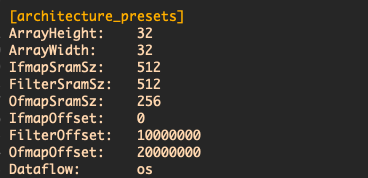Getting started is simple! SCALE-Sim is completely written in python. At the moment, it has dependencies on the following python packages. Make sure you have them in your environment.
- os
- subprocess
- math
- configparser
- tqdm
- Fill in the config file, scale.cfg with proper values.
- Run the command:
python scale.py - Wait for the run to finish
The config file scale.cfg contains two sections, achitecture presets and network presets.
Here is sample of the config file.

Architecture presets are the variable parameters for SCALE-Sim, like array size, memory etc.
Network preset contains just one field for now, that is the path to the topology csv file.
SCALE-Sim accepts topology csv in the format shown below.

Since SCALE-Sim is a CNN simulator please do not provide any layers other than convolutional or fully connected in the csv. You can take a look at yolo_tiny.csv for your reference.
Here is an example output dumped to stdout when running Yolo tiny (whose configuration is in yolo_tiny.csv):

Also, the simulator generates read write traces and summary logs at ./outputs/<topology_name>.
There are three summary logs:
- Layer wise runtime and average utilization
- Layer wise MAX DRAM bandwidth log
- Layer wise AVG DRAM bandwidth log
- Layer wise breakdown of data movement and compute cycles
In addition cycle accurate SRAM/DRAM access logs are also dumped and could be accesses at ./outputs/<topology_name>/layer_wise
For detailed insights on using SCALE-Sim, you can refer to this paper